Physical Address
304 North Cardinal St.
Dorchester Center, MA 02124
Elbow injuries in the throwing athlete are often the result of high valgus and extension forces that act on the elbow during the throwing motion. These forces place tensile stress on medial structures, compression stress on lateral structures, and shear stress posteromedially. Identification of the disorder and provision of appropriate treatment requires an accurate history, a thorough physical examination, and adequate ancillary testing. Common diagnoses in the throwing athlete with medial elbow pain include ulnar neuritis, ulnar collateral ligament (UCL) insufficiency or tear (valgus instability), flexor pronator strain or tendinopathy, and medial epicondylar apophysitis or avulsion (particularly in athletes whose skeletons are immature). Lateral elbow pain may result from osteochondritis dissecans of the capitellum, loose bodies, lateral epicondylitis, or radial nerve entrapment. Finally, posterior pain may indicate valgus extension overload (VEO) syndrome with posteromedial ulnohumeral osteophytes, trochlear chondromalacia, olecranon stress fracture, or distal triceps tendinopathy.
A thorough understanding of the complex anatomy and function of the elbow joint as well as of throwing biomechanics, is essential for physicians who treat overhead-throwing athletes. This chapter reviews elbow injuries in such athletes, focusing primarily on young skeletally mature adults, with an emphasis on pertinent anatomy and biomechanics where appropriate.
A careful history is the cornerstone of the systematic approach to all elbow pathology. Frequently the diagnosis and foundation of treatment are quickly elicited from a clear description of the thrower's injury or development of symptoms. Important features include symptom duration, location, timing within the throwing motion, previous injuries and treatments, and associated symptoms.
The timing of symptoms, whether acute or insidious in onset, should be noted first. Subtle clues tied to symptom onset are often revealing, such as a change in workout regimen or intensity; position changes; or advancement to a new league, level, or team. Changes in stamina, arm strength, velocity, or ball control are additional pieces of valuable information. A prior history of shoulder injury or pain may alert the clinician to a variation in throwing mechanics or muscle strength as the source of newfound elbow pain. It is therefore common for throwers to report elbow symptoms after undergoing treatment for a shoulder problem, and vice versa.
Elbow pain in the thrower often presents as an acute event superimposed on a chronic or subacute overuse injury. About half of patients with a UCL injury will present after an acute episode. The examiner should discern the competence of the UCL and the possibility of valgus instability as the primary pathology; often these athletes will report a history or treatment history of tendinopathy or ulnar neuritis for medial-sided pain or persistent posterior pain that was not relieved after arthroscopy for isolated posterior decompression. The location of symptoms is also critically important and is closely linked to the physical examination.
Knowledge of the six phases of the throwing motion is mandatory for the clinician because certain pathologies demonstrate symptoms at specific phases that can be reproduced by the athlete ( Fig. 64.1 ). Of athletes with medial elbow instability (UCL insufficiency), nearly 85% will experience pain during the acceleration phase of throwing whereas fewer than 25% will experience pain during the deceleration phase. Pain during late acceleration and cocking is often due to medial tensile stress (e.g., UCL insufficiency, medial epicondylitis, flexor-pronator strain, or ulnar neuritis), whereas pain with deceleration and follow-through often signifies posterior pathology (e.g., VEO, ulnohumeral osteophyte formation, loose bodies, or triceps tendinopathy).
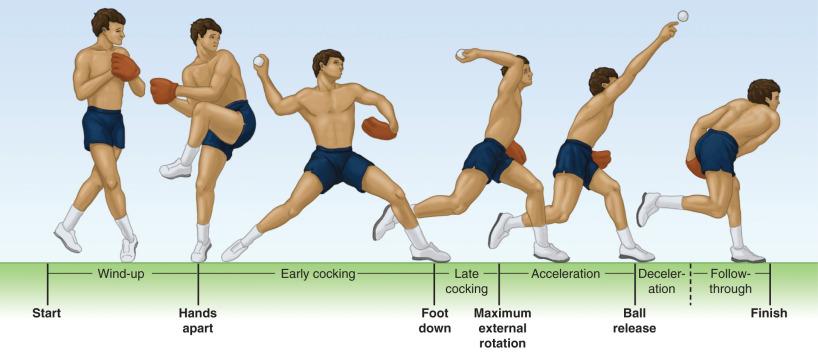
Other less common symptoms of a neurovascular etiology may occur in overhead-throwing athletes such as the development of cold intolerance, paresthesias in the hand or fingertips, or deterioration of fine motor skills and coordination. Although the ulnar nerve is most at risk in this population, compressive neuropathies of the radial or median nerves should be kept in mind.
Pitch intensity may also influence symptoms. Throwers with UCL insufficiency often remain asymptomatic at low levels of throwing intensity but have pain with throwing attempts at greater than 75% effort. Other throwers can long toss to 120 feet with high velocity but are unable to throw from a mound without significant pain.
Most acute UCL injuries occur at some point during regular-season competition, whereas injuries due to improper mechanics or training, such as flexor pronator tendinopathy or muscle strain, often present during early preparation or spring training. The clinician should specifically ask about warm-up, preseason preparation, “getting the arm in throwing shape,” and excessive pitch counts, because all these factors have been implicated in elbow injuries. Acute injuries are also seen when a position player attempts to begin pitching during a contest without adequate warm-up or preparation to condition the soft tissues. Overthrowing, or trying to exceed maximal velocity, is seen during tryouts or “showcases” and may herald injury. Year-‘round throwing without adequate rest and recovery has been implicated in the increased incidence of elbow injuries (especially involving the UCL) in young throwers. Many authors have commented on strategies aimed at preventing or minimizing elbow UCL injuries, particularly in the adolescent and teenage population of overhead athletes. Some strategies include utilizing pitch counts and limits, avoidance of year-round throwing or participation in throwing sports, and a focus on proper throwing technique and mechanics.
Examination of the elbow includes inspection, palpation, range of motion (ROM), and special tests to elucidate specific pathology.
The resting position of the elbow is first inspected for the carrying angle, which is formed by the long axis of the humerus and forearm at their articulation, with the elbow maximally extended. Normal values for the carrying angle are 11 to 13 degrees of valgus. In the elbows of overhead throwing athletes, however, the carrying angle may be increased as a result of the adaptive changes of repetitive stress.
The lateral “soft spot” between the capitellum, radial head, and olecranon should be assessed for soft tissue fullness and swelling, which could indicate the presence of a joint effusion. In this case, the patient will often maintain the elbow in 70 to 80 degrees of flexion, the position that maximizes the capsular volume.
Normal ROM of the elbow is from full extension—which may include slight hyperextension—to flexion at or slightly beyond 140 degrees. Motion should be symmetric to the contralateral side. In the overhead throwing athlete, loss of elbow extension may be either developmental or pathologic, and a flexion contracture of up to 15 or 20 degrees is not uncommon.
Both active and passive motion should be evaluated. A solid end point in flexion may be due to an impinging osteophyte within the coronoid fossa, whereas a firm block during terminal extension may be due to a posterior osteophyte on the tip of the olecranon or within the olecranon fossa. In either case, the end point will be firm, and attempts at further passive motion will often be painful. Softer end points may be a result of soft tissue swelling, capsular contracture, or a joint effusion.
Palpation of individual anatomic structures should be carried out sequentially to determine the most common potential sites of pathology. A key stabilizing structure in the elbow of the overhead throwing athlete is the UCL ( Fig. 64.2 ). Palpation of this structure is performed with the elbow between 50 and 70 degrees of flexion, which will move the flexor pronator mass anterior to the UCL.
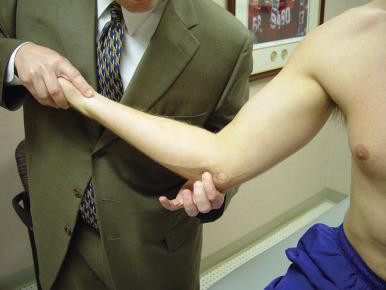
Tenderness along the course of the ligament, which runs from the inferior medial epicondyle to the sublime tubercle of the proximal ulna, may indicate injury. UCL injury may be differentiated from epicondylitis by performing the valgus stress test with the wrist in passive flexion and the forearm in pronation to eliminate tension on the flexor pronator mass. Heightening of medial-sided elbow pain with this modification likely indicates UCL injury rather than medial epicondylitis or muscle strain.
Lateral-sided structures of interest include the radial head, capitellum, lateral epicondyle, and extensor muscle mass. Crepitus over the radiocapitellar joint may indicate chondral injury or loose bodies. The radiocapitellar compression test can be used to diagnose radiocapitellar chondral degeneration and is performed by applying an axial load to the lateral elbow with neutral wrist position and repeated pronation and supination to elicit symptoms. In those with lateral epicondylitis, pain will be experienced with resisted wrist or long finger extension. In persons with radial tunnel syndrome, deep, aching pain is often experienced with palpation of the middle and distal forearm.
Anteriorly, the distal biceps tendon, brachialis muscle, and anterior capsule are evaluated. Posteriorly, the olecranon and distal triceps tendon are palpable and easily assessed. Tenderness over the posteromedial olecranon usually indicates VEO with osteophyte formation, whereas posterolateral tenderness may be associated with an olecranon stress fracture.
The ulnar nerve may be palpated proximal to the medial epicondyle, then through the cubital tunnel, and distally as far as possible into the flexor carpi ulnaris muscle mass. Gentle percussion of the nerve should not cause pain or discomfort in an otherwise healthy elbow. The Tinel sign may be elicited with radiating symptoms coursing distally into the ring and small fingers. If the nerve is unstable, it may subluxate or dislocate anterior to the medial epicondyle when the elbow is brought into maximal flexion. Anomalous bands of the distal triceps insertion have been described as a cause of ulnar nerve impingement and may cause a “snapping” sensation as they move across the medial epicondyle.
Certain special tests can be performed in the thrower's elbow to evaluate common throwing injuries. The most important structure to evaluate is, again, the UCL. Valgus stress testing is performed to evaluate injury to the anterior bundle of the UCL. Although cadaveric cutting studies have suggested 70 to 90 degrees of elbow flexion as the optimal position to isolate the contribution of the UCL to valgus stability, it is difficult to control humeral rotation and apply valgus stress at that angle; therefore testing is best performed at 20 to 30 degrees elbow flexion with the forearm pronated. Valgus stress testing may be performed with the patient seated upright, supine, and/or prone. Norwood and colleagues have described valgus stress testing with the forearm supinated and the elbow at 15 to 20 degrees of flexion to unlock the olecranon from the olecranon fossa. It is now recognized that forearm pronation prevents subtle posterolateral instability from mimicking medial laxity and is the preferred forearm position for valgus stress testing.
To perform the valgus instability test on the right elbow in the seated or supine position, the examiner stabilizes the humerus with the left hand just above the humeral condyles and applies a valgus moment with the right hand while grasping the patient's pronated forearm ( Fig. 64.3 ). In the prone position, the examiner stabilizes the humerus in 90 degrees of shoulder abduction with the right hand above the humeral condyles, flexes the elbow 20 to 30 degrees, and applies valgus stress with the left hand on the patient's pronated forearm. Comparison is made to the opposite elbow for both medial-sided joint opening and reproduction of pain. Detection of instability is often very subtle in the overhead throwing athlete because of the relatively small degree of medial opening that corresponds to a significant ligament injury. Field and colleagues have demonstrated that complete sectioning of the anterior bundle of the UCL increases medial opening by only 1 to 2 mm.
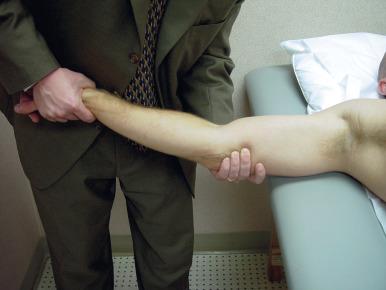
The “milking maneuver” has been described as a way to evaluate valgus stability. With the patient seated, the examiner grasps the thrower's thumb with the arm in the cocked position (90 degrees of shoulder abduction and 90 degrees of elbow flexion) and applies valgus stress by pulling down on the thumb ( Fig. 64.4 ). A variation of this test is performed with the examiner beginning in the position of the milking maneuver and slowly extending the elbow from 90 degrees of flexion to 20 degrees of flexion while applying valgus stress (i.e., pulling the thumb toward the floor).
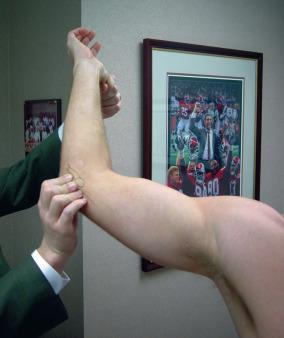
The VEO test may be performed to identify the presence of a posteromedial olecranon osteophyte or overgrowth in the olecranon fossa ( Fig. 64.5 ). With the humerus stabilized with one hand, the examiner's opposite hand pronates the forearm and applies a valgus force while quickly and maximally extending the elbow. A positive VEO test will cause pain posteromedially as the olecranon osteophyte engages the olecranon fossa.
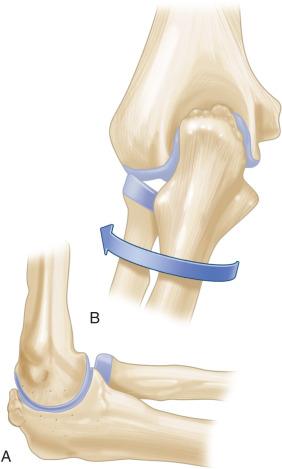
Our standard radiographic series of the thrower's elbow includes anteroposterior (AP), lateral, and axial views and two oblique views of the affected side. An oblique axial view taken with the elbow in 110 degrees of flexion may be helpful to demonstrate posteromedial olecranon osteophytes. If medial instability is suspected, stress AP radiographs may be performed with use of a valgus stress radiography machine (Telos, Weiterstadt, Germany). We typically obtain AP views with 0, 5, 10, and 15 N of valgus stress applied to each elbow at 25 degrees of flexion. An increase in the medial-sided joint opening with increasing stress, compared with the uninjured side, is indicative of UCL injury, although reference values for normal, healthy elbows have not been clearly established ( Fig. 64.6 ). Radiographs are evaluated for the presence of olecranon osteophytes, calcification within the UCL (possibly indicating previous injury), osteochondral damage to the capitellum, or osseous loose bodies. A bone scan and/or computed tomography (CT) may be useful for detecting olecranon stress fractures.
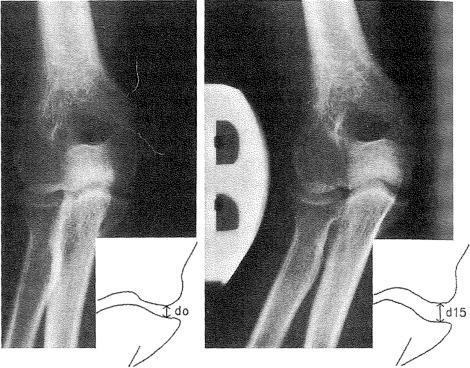
Magnetic resonance arthrography (MRA) with the use of intra-articular contrast or saline enhancement has emerged as our imaging modality of choice to assess intra-articular pathology in the thrower's elbow. Schwartz et al. reported 92% sensitivity and 100% specificity with saline-enhanced MRA in the diagnosis of UCL tears, with sensitivity for accurate diagnosis of complete tears greater than that for partial tears ( Fig. 64.7 ). The lateral soft spot is the entry point for injection of saline solution, and extravasation through the UCL is diagnostic for full-thickness injury. Other advantages of MRA include assessment of possible osteocartilaginous loose bodies, osteochondral fragments, and bone marrow edema that may suggest a stress reaction or fracture.
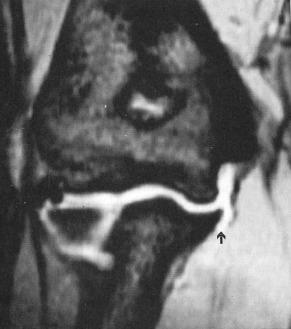
Other authors have advocated the use of musculoskeletal ultrasound for assessing normal and abnormal anatomy of the UCL. This has the advantage of being able to study the ligament and surrounding anatomy in static or dynamic fashion, is noninvasive, and can also have the benefit of comparing the contralateral side via examination in the same setting.
The cornerstone for successful management of the overhead throwing athlete with elbow pain is accurate diagnosis of the problem. To this end, the history and physical examination form the framework for identifying potential pathologic conditions. Ancillary imaging modalities or other tests are then used to confirm the diagnosis and extent of pathology.
Once an accurate diagnosis has been established, a few core principles may be followed to help guide the clinician in management issues. First, full-thickness and many high-grade partial-thickness tears of the UCL may be tolerated in nonthrowers during routine activities of daily living, but they are frequently poorly tolerated in overhead throwing athletes because of the high tensile stresses and valgus force across the medial elbow during these activities. This subgroup of patients often requires surgery to diminish symptoms and pain if they wish to continue overhead throwing. Second, a majority of other injuries, and certainly many partial UCL tears or strains, can be successfully treated nonsurgically; therefore a formal rehabilitative program specific to overhead throwing athletes is critical to management and outcome. The return-to-play (RTP) throwing program that we implement for the overwhelming majority of our patients is detailed later in this chapter.
The final issue in decision-making relates to the patient's level of competitive play and the time point within the season (or off season). Most UCL injuries occur during regular season competition, whereas injuries relating to improper mechanics or training (e.g., flexor pronator strain or tendinopathy) often present during early preparation or spring training. Given the lengthy time until RTP after UCL reconstruction, professional pitchers must consider contractual issues, and the clinician may be wise to include input from family members, coaches, trainers, agents, and other support staff during the evaluation and treatment process.
Tendon injuries around the elbow range from minor degeneration to complete rupture of the flexor pronator musculature. Flexor pronator tendinosis is common in throwers because of the muscles’ dynamic contribution to elbow stability during the valgus torque produced during cocking and arm acceleration. The flexor carpi ulnaris is the primary dynamic stabilizer against valgus stress. In such cases of tendinopathy, patients have tenderness to palpation immediately distal to the common tendon origin at the medial epicondyle and increased pain with valgus stress. Careful attention to the location of pain will likely distinguish tendinopathy from UCL injury, which usually elicits tenderness more distally and posteriorly. Resisted forearm pronation and wrist flexion is more likely to cause pain in cases of tendinopathy compared with UCL injury. Distal triceps tendinopathy is also seen in throwers as a result of the rapid elbow extension required during the acceleration phase. In these cases, the pain is easily traced to the distal triceps tendon insertion at the olecranon tip. In addition, resisted elbow extension may exacerbate symptoms.
As with other locations of tendinopathy, the treatment begins with rest from aggravating activities and use of anti-inflammatory medication, followed by a stretching and strengthening program. Therapeutic modalities and occasional corticosteroid injection have also demonstrated some beneficial effect. In general corticosteroid injection is reserved for recurrent or recalcitrant cases of tendinopathy. With progressive stretching and strengthening of the injured tendon structure of interest (typically the origin or insertion of the tendon), many players can return to competition after 1 to 3 weeks of treatment. In more chronic or recurrent cases, the required period of rest and treatment may be prolonged. In the few cases in which conservative measures fail to result in improvement, operative débridement of the flexor pronator origin or triceps insertion may be performed through an open approach. Similarly, in cases of chronic degenerative tendinosis, we prefer open débridement and repair of the flexor pronator mass. In these cases we reattach the healthy tendon origin to the medial epicondyle using a suture anchor. Although the results of operative treatment are excellent, most cases do not require this type of management. In fact, if nonoperative methods fail and surgery is considered necessary, a concomitant injury such as UCL insufficiency must be considered.
Treatment options for UCL injury include nonoperative rehabilitation, direct repair of the ligament, or reconstruction using a free tendon graft.
Nonoperative treatment of UCL injuries is generally indicated in nonthrowing athletes or for injuries to the nondominant elbow; it has acceptable results in this lower-demand population. UCL-deficient athletes in sports that involve throwing and that place a high demand on the elbow do not respond well to nonoperative management on a consistent basis.
Rehabilitation for a patient with an injured UCL should begin with a period of active rest. During the initial 2 to 6 weeks after the injury, throwing should cease while the patient focuses on cryotherapy, motion recovery, and strengthening of wrist flexors and the flexor-pronator mass at the elbow. Weakness of the throwing shoulder may increase the stresses on the elbow during the throwing motion, and thus rehabilitation of any elbow injury must include strengthening of the shoulder girdle, rotator cuff, and scapular stabilizers. Significant internal rotation deficits of the glenohumeral joint should be addressed with posterior capsular stretching. As soreness dissipates, strengthening of the flexor pronator muscles of the forearm should begin.
Once the inflammatory phase has subsided, a detailed program of elbow rehabilitation begins—including functional exercises, plyometrics, and sport-specific exercises—concluding with an interval throwing program. RTP may be considered after completion of the entire program and if the athlete remains free of pain. There is growing utilization and research conducted on use of treatments such as platelet-rich plasma (PRP) for partial UCL injuries or in very young, skeletally immature athletes; these have met with reasonable success and represent an area of ongoing research.
Operative treatment of the UCL is indicated in the symptomatic overhead throwing athlete with a complete tear of the anterior bundle of the UCL as determined by history, physical examination, and imaging studies ( Fig. 64.8 ). In general surgery is necessary if the athlete wishes to return to competitive throwing. Surgery is also considered in athletes with a partial UCL injury who fail to return to their prior level of competition after undergoing a comprehensive rehabilitation program. Certainly a thrower who places high demands on the elbow—such as a baseball pitcher, quarterback, or javelin thrower—is much more likely to require UCL reconstruction even with a more minor partial injury. These athletes may not respond favorably to nonoperative management.
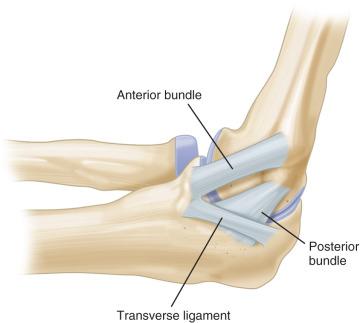
Direct primary UCL repair in the overhead throwing athlete has been reported in several series, but in general results have been inferior compared with results of reconstructive procedures. Conway et al. have described treatment of UCL deficiency in overhead throwing athletes with either repair or reconstruction. At follow-up examination, 50% (7 of 14) of the group that underwent repair had returned to the same level of sport, compared with 68% (38 of 56) of the reconstruction group. Overall, 80% of the reconstruction group had good or excellent results, compared with 71% of the primary repair group, indicating improved results with reconstruction versus repair.
Timmerman and colleagues also documented better outcomes with reconstruction rather than repair in a subset of professional baseball players. In this group, neither of the two patients who underwent direct UCL repair was able to RTP, compared with 12 of 14 patients (86%) who underwent reconstruction.
Azar and colleagues reported on the treatment of UCL deficiency in athletes with either reconstruction or repair. Of the eight patients who underwent primary repair, five (63%) were able to RTP at the same or a higher level of competition versus 81% (48 of 59) in the reconstruction group. The authors concluded that UCL reconstruction is superior to repair in overhead throwing athletes. For these reasons isolated direct primary repair of UCL injury is not performed at our institution.
Jobe and colleagues first described the technique for UCL reconstruction using a free tendon graft in a figure-eight fashion through bone tunnels, suturing the graft to itself. The flexor pronator mass was detached from the medial epicondyle and submuscular ulnar nerve transposition was performed. Since that time several modifications have been made to Jobe's original method. Andrews modified the procedure by elevating the flexor-pronator mass without detaching it from the medial epicondyle and performing a subcutaneous ulnar nerve transposition. Others split the muscle and leave the nerve in situ. Rohrbough and coauthors secured the tendon graft through a single humeral tunnel, calling it the docking procedure . This involves passing the graft through the ulna (described further on under Authors’ Preferred Technique: UCL Reconstruction); however, the medial epicondyle is opened using a 3-mm round burr without exiting the proximal aspect of the medial epicondyle. A small dental drill is then used to make two smaller converging tunnels in the epicondyle connecting to the larger burr hole. The two tails of the graft are passed from distal to proximal in a divergent manner through the two tunnels and tied to one another atop the epicondyle. This technique does not typically include ulnar nerve transposition and has been noted to involve less soft tissue dissection than the standard technique first described by Jobe and colleagues ( Figs. 64.9 and 64.10 ). Another technique involves a single tunnel at both the medial epicondyle and sublime tubercle, with graft fixation achieved by using soft tissue bioabsorbable interference screws.
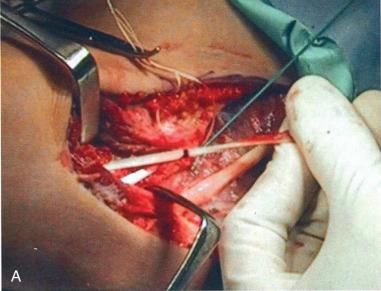

UCL injury is not the only cause of medial elbow pain in the overhead throwing athlete. VEO is a condition precipitated by the forces of the throwing motion acting at the elbow joint in which impingement of the posteromedial olecranon tip against the medial wall of the olecranon fossa occurs. With repeated impingement, osteophytes may emerge at the ulnohumeral point of contact, typically posteriorly or posteromedially. Olecranon osteophytes may fracture and produce loose bodies capable of migrating into any intra-articular compartment. Bony overgrowth within the olecranon fossa of the distal humerus is also common. Additional symptoms of pain and swelling may be due to localized synovial hypertrophy in the same region. Throwers typically report posteromedial elbow pain at the initiation of the acceleration phase, although symptoms may also be elicited during the deceleration and follow-through phases. The distinction between this condition and UCL injury is difficult but can usually be made by carefully determining the exact location of the pain that the patient experiences. With VEO, the pain of greatest magnitude is typically more proximal with direct palpation of the posteromedial tip of the olecranon. The provocative test for VEO is the VEO test, which is an important aspect of this diagnosis. In the case of UCL injury, the VEO test may also elicit pain, which is generally located more distal in the area of the ligament's insertion.
Once VEO is diagnosed, a conservative treatment protocol similar to those described earlier should be instituted, including active rest and rehabilitation that entails both shoulder and elbow exercises with avoidance of throwing. A return to graduated interval throwing can be permitted once symptoms diminish.
When conservative measures fail to resolve the problem, open or arthroscopic débridement of impinging osteophytes and removal of associated loose bodies is undertaken, followed by an appropriate rehabilitative program. Park et al. reported on a small group of adolescent baseball players who underwent arthroscopic excision of the olecranon tip with favorable outcomes at a minimum 2-year follow-up.
Although traumatic elbow fractures are possible in the pediatric population, olecranon stress fractures are more common in adult throwers. The olecranon process is the most common stress fracture site among baseball players. These overuse injuries typically present with pain during the acceleration phase of throwing, which is localized to the posterior and sometimes the lateral border of the ulna at the level of the olecranon articular surface. Physical examination in these cases is unlikely to yield pain with valgus stress. Rather, these throwers will have point tenderness to palpation over the affected site. In the more chronic cases, these stress fractures are apparent on plain radiographs ( Fig. 64.11 ), indicated by a focal sclerotic reaction. CT, bone scan, or MRI are viable imaging modalities when plain films are negative, but a high clinical suspicion exists ( Fig. 64.12 ). Early lesions diagnosed by advanced imaging may be managed nonoperatively. Injuries that present later with sclerotic changes are more resistant to nonoperative treatment and may therefore benefit from operative treatment.
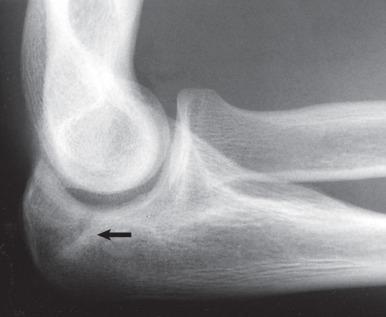
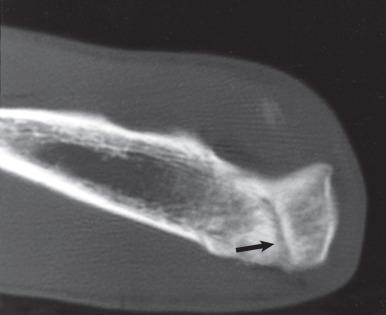
There have been no large clinical series to guide treatment of this overuse condition. Several anecdotal reports have demonstrated some success with both conservative and operative management. In our clinic, treatment of stress fractures of the olecranon begins with rest from throwing along with strictly enforced lifting restrictions. Rotator cuff exercises, along with plyometrics and light triceps and biceps strengthening, may be initiated once the point tenderness ceases. A bone growth stimulator may be used to expedite union. Once clinical symptoms dissipate and radiographic union is confirmed, rehabilitation may progress to an interval throwing program. If symptoms persist despite this algorithm, surgical intervention is considered. A single longitudinally oriented 6.5- or 7.3-mm cannulated partially threaded screw inserted through the distal triceps tendon is our treatment of choice in these cases ( Fig. 64.13 ). Early ROM exercises are instituted, followed by strengthening and return to throwing when healing is apparent, which typically is around 6 weeks after surgery. Screw removal is entertained only if the patient has obvious symptoms and union has been confirmed. Not all throwers will require removal of the screw.
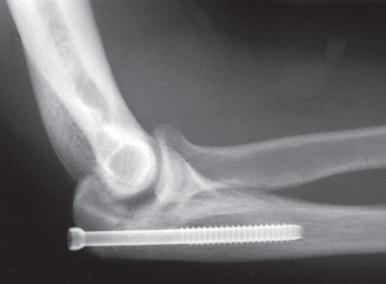
Irritation or compromise of the ulnar nerve related to repeated valgus stress at the elbow has been seen in overhead throwing athletes with medial elbow instability. A significant amount of stress is exerted on the ulnar nerve during the throwing motion. A study by Aoki and colleagues found that the maximal strain on the ulnar nerve during the acceleration phase was close to the elastic and circulatory limits of the nerve. Besides the propagated tensile stresses, other factors thought to affect the nerve included friction, compression from local adhesions, regional osteophytes or muscle hypertrophy, or the presence of an anconeus epitrochlearis muscle over the cubital tunnel. Symptomatic throwers may report intermittent paresthesias in the medial forearm radiating to the ring and small finger as well as aching discomfort in the medial elbow or forearm. Patients may demonstrate a Tinel sign or symptoms with compression over the affected portion of the nerve. The situation may be worsened by ulnar nerve instability, although evident subluxation may be symmetric with the nonthrowing arm or may itself be asymptomatic. Nonoperative measures to consider include periodic splinting of the elbow in extension or the use of an elbow pad to minimize external pressure on an inflamed, irritated nerve. If symptoms fail to improve after short-term rest, use of anti-inflammatory medication, and physical therapy, ulnar nerve decompression and transposition may be recommended.
Our current preferred method of surgical treatment for recalcitrant ulnar neuritis or neuropathy is anterior subcutaneous transposition ( Fig. 64.14 ). A 4- to 5-cm medial incision is centered over the medial epicondyle. Traversing posterior branches of the medial antebrachial cutaneous nerve are identified and protected and the ulnar nerve is carefully dissected from the cubital tunnel. Complete release is performed beginning at the arcade of Struthers proximally and extending 2 to 3 cm into the flexor carpi ulnaris muscle. A slip of the medial intermuscular septum is developed to use later for the transposition, and the flexor pronator fascia is closed. The ulnar nerve is transposed subcutaneously, anterior to the medial epicondyle, and held loosely in place by suturing the distally based slip of medial intermuscular septum to the flexor fascia. Care must be taken to make sure that the fascia does not act as a point of nerve impingement. The posterior triceps fascia is then sutured to the medial epicondyle to close the cubital tunnel, and the flexor carpi ulnaris fascial split is reapproximated loosely. A drain is placed and the wound is closed in two layers with a subcuticular closure. The elbow is splinted in 90 degrees of elbow flexion for the first week postoperatively to allow soft tissue healing, followed by progressive motion and rehabilitation.
Our preferred method for UCL reconstruction is a modification of the original technique described by Jobe et al. These modifications include elevation rather than detachment of the flexor-pronator muscle mass and subcutaneous rather than submuscular ulnar nerve transposition.
The procedure requires the patient to be positioned supine with the arm on a hand table. After induction of general anesthesia, a nonsterile tourniquet is inflated to 250 mm Hg. The incision is made, extending from 4 cm above the medial epicondyle to 6 cm distal to it. Cutaneous nerve branches are protected. The ulnar nerve is isolated above and below the medial epicondyle, and both regions of the nerve are tagged with vessel loops. Ulnar nerve release must continue proximally to the arcade of Struthers and distally into the flexor carpi ulnaris muscle mass. The medial intermuscular septum is excised to prevent tethering of the nerve when it is transposed. Next, the flexor-pronator mass is elevated off the underlying joint capsule until the UCL complex is completely visualized. The origin of the flexor-pronator tendon is left attached to the medial epicondyle. The anterior band of the UCL is identified at its distal attachment at the sublime tubercle. The native ligament is split longitudinally in line with its fibers to expose the underlying ulnohumeral joint as well as to visualize potential pathology within the deep portion of the ligament. The torn or degenerative ligament tissue may be débrided at this stage of the operation, although débridement is not mandatory ( Fig. 64.15 ).
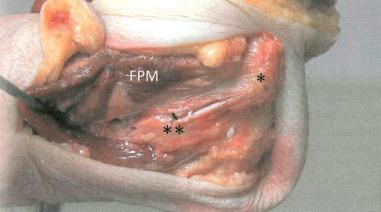
If concomitant valgus extension overload is suspected, then a vertically oriented posterior capsulotomy is performed proximal to the fibers of the posterior band of the UCL to visualize any osteophytes that may be present at the tip of the olecranon. If osteophytes are present, a small osteotome and/or a high-speed burr can be used to remove them. At this time the posterior compartment should also be inspected for loose bodies or damage to the articulating chondral surfaces, representing a potential “kissing lesion” of the trochlea. The capsulotomy should then be closed with absorbable suture.
Next, the graft is harvested. The ipsilateral palmaris longus tendon is our current graft of choice, followed by the contralateral palmaris longus, gracilis, plantaris, or toe extensor tendon. The palmaris longus tendon is harvested with three small incisions on the volar forearm beginning at the proximal wrist crease. Care must be taken to ensure harvest of the palmaris longus tendon rather than the similar-appearing flexor carpi radialis tendon. The median nerve lies deep to the palmaris longus tendon and should be protected during harvest by avoiding deep dissection below the forearm fascia. The minimum graft length necessary for UCL reconstruction is 12 cm.
A 9/64 drill bit is then used to create two connecting holes in the sublime tubercle of the proximal ulna, one from medial to lateral and one from anterior to posterior, leaving an adequate bone bridge ( Fig. 64.16 ). Curved curets can be used to connect the two holes if necessary. The same-sized drill bit is used to make two converging holes in the medial epicondyle, one from proximal to distal and one from medial to distal. These two holes should converge to exit the epicondyle at the origin of the UCL. Straight curets may be used to connect these holes if necessary. Suture passers are then used to pull suture loops through these tunnels. The distal end of the native ligament is repaired side to side using nonabsorbable suture for supplemental stability, leaving the most proximal ligament unrepaired. By closing the native ligament, the joint surfaces are also covered, which protects the graft from abrasion. The proximal ligament is not repaired at this time so that the entrance to the epicondylar tunnels can be visualized. If the native ligament was torn away from either insertion, sutures may be placed in the leading edges of the ligament for the purpose of repair through the tunnels for the graft. Nonabsorbable braided sutures are placed at each end of the graft tissue in Bunnell or Krackow fashion. The graft is then passed through the tunnels using suture passers and sewn to itself with the elbow positioned at 30 degrees of flexion and the joint reduced with varus stress ( Fig. 64.17 ). The graft is secured side to side with multiple nonabsorbable sutures. We routinely perform subcutaneous transposition of the ulnar nerve at the time of UCL reconstruction. The nerve is held in place with a single fascial sling from either the flexor-pronator muscle fascia or the released intermuscular septum, which is left attached to the medial epicondyle. The sling is created with loose tension to prevent any excessive compression of the ulnar nerve with elbow motion. The skin is closed with subcuticular suture, and the elbow is splinted at 90 degrees of flexion for the first week after surgery to allow soft tissue healing. A supervised four-phase postoperative rehabilitation program follows (see later).
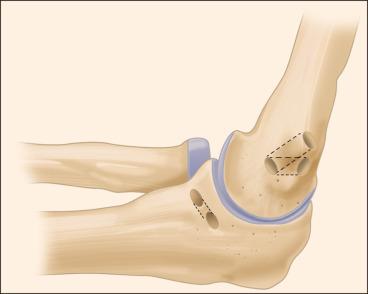
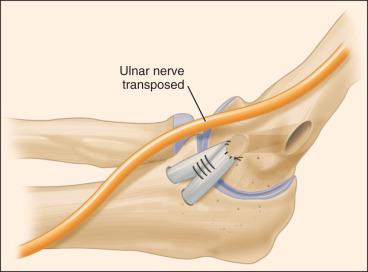
Arthroscopic elbow débridement may be performed with the patient in the supine, prone, or lateral decubitus position. We prefer the supine position with the arm in 90 degrees of abduction and the elbow in 90 degrees of flexion, suspended by an overhead traction device. A tourniquet set at 250 mm Hg is routinely used, and use of a pressure-sensitive arthroscopic pump is helpful to allow adequate visualization and prevent over distention of the joint. Initially all bony landmarks and portal locations are marked with a methylene blue pen, as described by Andrews and Carson, and the elbow is injected with 30 mL of saline solution through the lateral soft spot ( Fig. 64.18 ). A detailed knowledge of elbow anatomy is critical for proper portal placement. The anterolateral portal is established; diagnostic arthroscopy of the anterior compartment is performed through this portal. An anteromedial portal is established, with use of a spinal needle to assist with proper placement; however, in overhead throwing athletes, the anteromedial portal may not be created if no overt pathology is seen from the anterolateral portal. The anterior compartment is thoroughly evaluated for (1) loose bodies; (2) evidence of chondral damage to the coronoid process, capitellum, or radial head; or (3) osteophyte formation in the coronoid fossa. Because loose bodies from the posterior or lateral compartments often migrate to the anterior compartment or vice versa, all compartments must be thoroughly visualized.
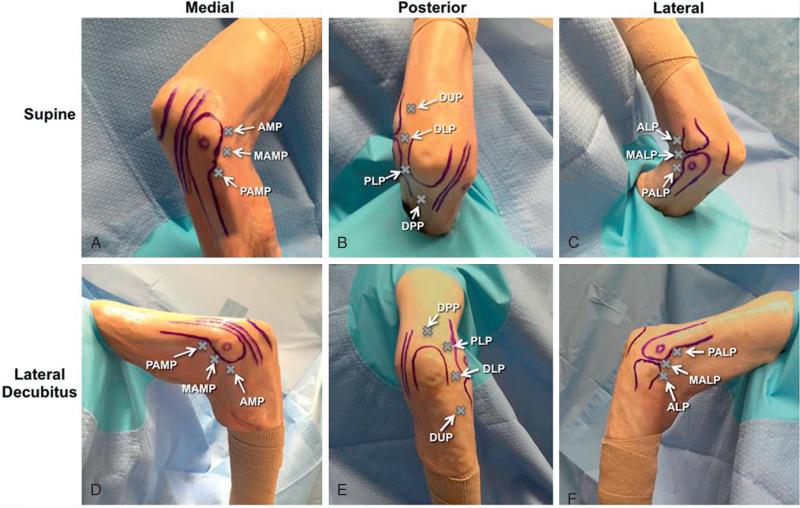
An arthroscopic valgus stress test is performed at 70 degrees of elbow flexion to evaluate the stability of the ulnar collateral ligament, with a medial opening of greater than 1 to 2 mm suggesting UCL insufficiency. A lateral soft spot portal is then established for the 2.7-mm arthroscope at the site of initial elbow injection. A second lateral portal may be placed approximately 1 cm distal to the first lateral portal for instrumentation of the lateral compartment or removal of loose bodies.
A posterolateral portal is established for placement of the 4.0-mm arthroscope, and an accessory straight posterior portal is then established through the triceps tendon, with care taken to avoid the ulnar nerve within the cubital tunnel. With the arthroscope in the posterolateral portal, a shaver is introduced through the accessory (straight) posterior portal to débride synovitis and soft tissue from the olecranon tip and olecranon fossa so that the entire bony margin of the olecranon tip can be visualized and associated loose bodies identified. The kissing lesion at the medial ulnotrochlear articulation is also débrided. The olecranon osteophyte is then excised with a sharp osteotome and burr. The amount of olecranon osteophyte that can safely be excised is unknown ( Fig. 64.19 ). We remove only enough bone to allow full elbow extension without bony impingement—approximately 3 to 5 mm. A lateral radiograph is then obtained intraoperatively to ensure that adequate bone has been removed and that no bone debris remains in the extra-articular soft tissues around the elbow. A compressive dressing is applied, and the arm is iced and elevated postoperatively. Early rehabilitation, with an emphasis on early recovery of motion, is initiated after surgery.
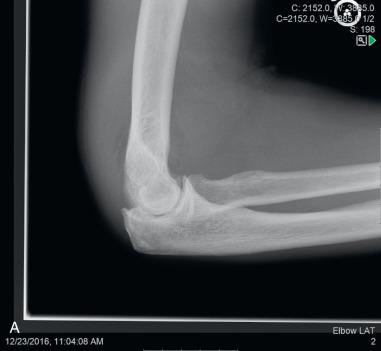
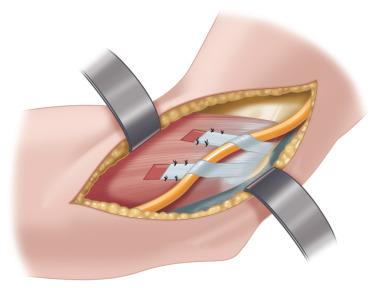
Become a Clinical Tree membership for Full access and enjoy Unlimited articles
If you are a member. Log in here